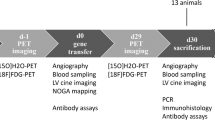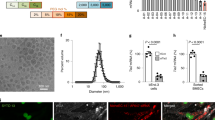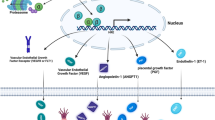Abstract
Nitric oxide synthase gene therapy has been shown to be effective at inducing apoptosis in experimental tumours and sensitizing them to radiotherapy. We have also shown that expression of inducible nitric oxide synthase (iNOS) can be effectively restricted to the tumour volume by the use of the radiation inducible promoter (WAF1) to drive the transgene in clinically relevant protocols. A synthetic construct (pE9), incorporating nine radiosensitive CArG elements from the Egr1 promoter, has recently been developed for cancer gene therapy. We have now investigated basal gene expression of transgenes driven by this promoter to assess its suitablility for use in iNOS gene therapy protocols in vivo. Transfection of human microvascular endothelial cells (HMEC-1) with pE9iNOS, using a cationic lipid vector, resulted in progressively increasing (<5-fold) levels of iNOS protein expression up to 8 h after transfection. Transfection of an ex vivo rat artery preparation with pE9iNOS caused 83% inhibition of response to the vasoconstrictor phenylephrine (PE). CMViNOS transfection also reduced response to PE, but by only 52%. A single injection of 25 μg of pE9iNOS DNA in a lipid vector into the centre of a murine sarcoma (RIF1) induced iNOS protein expression by four-fold and increased nitrite concentration eight-fold. This caused a 7-day delay in tumour growth and was more effective than the constitutive CMV-driven construct. Our data suggest that generation of NO•, as a result of iNOS overexpression, is capable of further activating the E9 promoter, through a positive feedback loop, yielding stronger and sustained levels of NO•. This pE9iNOS combination may, therefore, be particularly useful in an anticancer gene therapy strategy as its antitumour effect in vivo was clearly superior to that of the strong constitutive promoter, CMV.
This is a preview of subscription content, access via your institution
Access options
Subscribe to this journal
Receive 12 print issues and online access
$259.00 per year
only $21.58 per issue
Buy this article
- Purchase on Springer Link
- Instant access to full article PDF
Prices may be subject to local taxes which are calculated during checkout





Similar content being viewed by others
References
Kramer MG et al. In vitro and in vivo comparative study of chimeric liver-specific promoters. Mol Ther 2003; 7: 375–385.
McArt JA et al. Development of a melanoma-specific adenovirus. Mol Ther 2002; 6: 471–480.
Liu BH et al. CMV enhancer/human PDGF-beta promoter for neuron-specific transgene expression. Gene Therapy 2004; 11: 52–60.
Abdul-Ghani R et al. Use of transcriptional regulatory sequences of telomerase (hTER and hTERT) for selective killing of cancer cells. Mol Ther 2000; 2: 539–544.
Cao G et al. Effective and safe gene therapy for colorectal carcinoma using the cytosine deaminase gene directed by the carcinoembryonic antigen promoter. Gene Therapy 1999; 6: 83–90.
Cowen RL et al. Hypoxia targeted gene therapy to increase the efficacy of tirapazamine as an adjuvant to radiotherapy: reversing tumor radioresistance and effecting cure. Cancer Res 2004; 64: 1396–1402.
Guilhon E et al. Image-guided control of transgene expression based on local hyperthermia. Mol Imaging 2003; 2: 1–7.
Li GC et al. Adenovirus-mediated heat-activated antisense Ku70 expression radiosensitizes tumor cells in vitro and in vivo. Cancer Res 2003; 63: 3268–3274.
Kufe D, Weichselbaum R . Radiation therapy: activation for gene transcription and the development of genetic radiotherapy-therapeutic strategies in oncology. Cancer Biol Ther 2003; 2: 326–329.
Chtarto A et al. Minocycline-induced activation of tetracycline-responsive promoter. Neurosci Lett 2003; 352: 155–158.
Worthington J et al. Modification of vascular tone using iNOS under the control of a radiation-inducible promoter. Gene Therapy 2000; 7: 1126–1131.
Worthington J, Robson T, O'Keefe M, Hirst DG . Tumour cell radiosensitization using constitutive (CMV) and radiation inducible (WAF1) promoters to drive the iNOS gene: a novel suicide gene therapy. Gene Therapy 2002; 9: 263–269.
Worthington J et al. Use of the radiation-inducible WAF1 promoter to drive iNOS gene therapy as a novel anti-cancer treatment. J Gene Med 2004; 6: 673–680.
Datta R et al. Ionizing radiation activates transcription of the EGR1 gene via CArG elements. Proc Natl Acad Sci USA 1992; 89: 10149–11053.
Takahashi T, Namiki Y, Ohno T . Induction of the suicide HSV-TK gene by activation of the Egr-1 promoter with radioisotopes. Human Gene Ther 1997; 8: 827–833.
Hallahan D et al. Spatial and temporal control of gene therapy using ionizing radiation. Nat Med 1995; 1: 786–791.
Seung LP et al. Genetic radiotherapy overcomes tumour resistance to cytotoxic agents. Cancer Res 1995; 55: 5561–5565.
Marples B et al. Development of synthetic promoters for radiation-mediated gene therapy. Gene Therapy 2000; 7: 511–517.
Marples B, Greco O, Joiner M, Scott S . Molecular approaches to chemo-radiotherapy. Eur J Cancer 2002; 38: 231–239.
Scott S, Joiner M, Marples B . Optimizing radiation-responsive gene promoters for radiogenetic cancer therapy. Gene Therapy 2002; 9: 1396–1402.
Greco O et al. Novel chimeric gene promoters responsive to hypoxia and ionizing radiation. Gene Therapy 2002; 9: 1403–1411.
Datta R et al. Reactive oxygen intermediates target CC(A/T)6GG sequences to mediate activation of the early growth response 1 transcription factor gene by ionizing radiation. Proc Natl Acad Sci USA 1993; 90: 2419–2422.
Mitchell JB et al. Hypoxic mammalian cell radiosensitization by nitric oxide. Cancer Res 1993; 53: 5845–5848.
Griffin RJ, Makepeace CM, Hur WJ, Song CW . Radiosensitization of hypoxic tumor cells in vitro by nitric oxide. Int J Radiat Oncol Biol Phys 1996; 36: 377–383.
Kurimoto M et al. Growth inhibition and radiosensitization of cultured glioma cells by nitric oxide generating agents. J Neurooncol 1999; 42: 35–44.
Chung HT et al. Nitric oxide as a bioregulator of apoptosis. Biochem Biophys Res Commun 2001; 282: 1075–1079.
Van de Casteele M, Hosli M, Sagesser H, Reichen J . Intraportal administration of glyceryl trinitrate or nitroprusside exerts more systemic than intrahepatic effects in anaesthetised cirrhotic rats. J Hepatol 1999; 31: 300–305.
Robson T, Hirst DG . Transcriptional targeting in cancer gene therapy. J Biomed Biotech 2003; 2: 110–137.
Greco O, Marples B, Joiner M, Scott S . How to overcome (and exploit) tumor hypoxia for targeted gene therapy. J Cell Physiol 2003; 197: 312–325.
Weichselbaum RR, Hallahan D, Fuks Z, Kufe D . Radiation induction of immediate early genes: effectors of the radiation-stress response. Int J Radiat Oncol Biol Phys 1994; 30: 229–234.
Wang Z et al. Adenoviral gene transfer of the human inducible nitric oxide synthase gene enhances the radiation response of human colorectal cancer associated with alterations in tumor vascularity. Cancer Res 2004; 64: 1386–1395.
Karihtala P, Kinnula VL, Soini Y . Antioxidative response for nitric oxide production in breast carcinoma. Oncol Rep 2004; 12: 755–759.
Kao CL et al. Elevated nitric oxide levels in childhood brain tumors. Childs Nerv Syst 2003; 19: 744–749.
Wang J et al. Expression of inducible nitric oxide synthase in paired neoplastic and non-neoplastic primary prostate cell cultures and prostatectomy specimen. Urol Oncol 2003; 21: 117–122.
Gallo O et al. Down-regulation of nitric oxide synthase-2 and cyclooxygenase-2 pathways by p53 in squamous cell carcinoma. Am J Pathol 2003; 163: 723–732.
Chung P et al. Overexpression of the human inducible nitric oxide synthase gene enhances radiation-induced apoptosis in colorectal cancer cells via a caspase-dependent mechanism. Nitric Oxide 2003; 8: 119–126.
Khare PD et al. Tumor growth suppression by a retroviral vector displaying scFv antibody to CEA and carrying the iNOS gene. Anticancer Res 2002; 22: 2443–2446.
Heigold S et al. Nitric oxide mediates apoptosis induction selectively in transformed fibroblasts compared to nontransformed fibroblasts. Carcinogenesis 2002; 23: 929–941.
Hemmrich K, Suschek CV, Lerzynski G, Kolb-Bachofen V . iNOS activity is essential for endothelial stress gene expression protecting against oxidative damage. J Appl Physiol 2003; 95: 1937–1946.
Suschek CV et al. Even after UVA-exposure will nitric oxide protect cells from reactive oxygen intermediate-mediated apoptosis and necrosis. Cell Death Differ 2001; 8: 515–527.
Acknowledgements
This work was funded by project Grants C1278/A3608 (DGH, JW, TR) and SP2490/0101 (SDS) from Cancer Research UK.
Author information
Authors and Affiliations
Rights and permissions
About this article
Cite this article
Worthington, J., Robson, T., Scott, S. et al. Evaluation of a synthetic CArG promoter for nitric oxide synthase gene therapy of cancer. Gene Ther 12, 1417–1423 (2005). https://doi.org/10.1038/sj.gt.3302552
Received:
Accepted:
Published:
Issue Date:
DOI: https://doi.org/10.1038/sj.gt.3302552
Keywords
This article is cited by
-
Rapid identification of novel functional promoters for gene therapy
Journal of Molecular Medicine (2012)
-
The radiation-inducible pE9 promoter driving inducible nitric oxide synthase radiosensitizes hypoxic tumour cells to radiation
Gene Therapy (2008)
-
p21(WAF1)-mediated transcriptional targeting of inducible nitric oxide synthase gene therapy sensitizes tumours to fractionated radiotherapy
Gene Therapy (2007)



